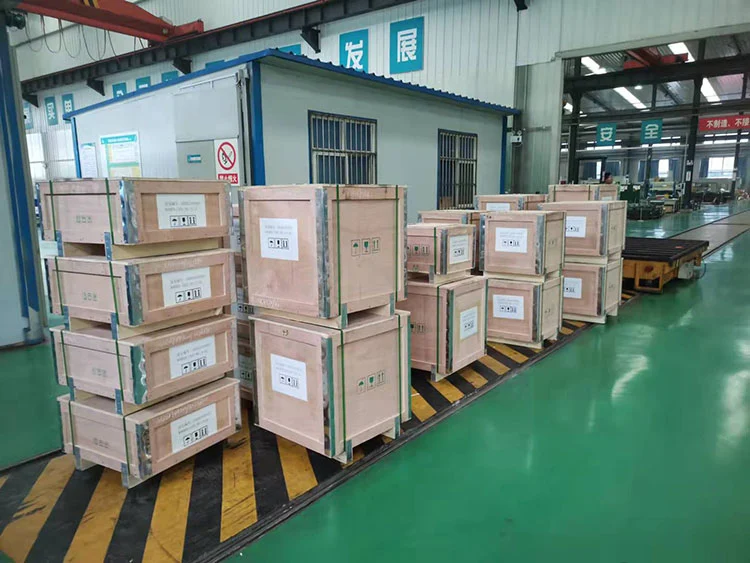Technological Innovations in Roller Slewing Bearing Design
Roller slewing bearings have revolutionized the way heavy machinery operates, providing crucial support for rotational movement in various industries. As technology advances, so does the design and functionality of these essential components. This blog explores the latest technological innovations in roller slewing bearing design, showcasing how these advancements are reshaping industries from construction to renewable energy. We'll delve into cutting-edge materials, improved manufacturing processes, and enhanced performance characteristics that are pushing the boundaries of what's possible in heavy-duty applications. From increased load-bearing capacities to reduced maintenance requirements, these innovations are not only improving efficiency but also extending the lifespan of machinery across diverse sectors. Join us as we uncover the engineering marvels behind modern roller slewing bearings and their impact on industrial progress.
What are the latest advancements in roller slewing bearing materials?
High-Performance Alloys
Recent innovations in roller slewing bearing design have seen the introduction of high-performance alloys that significantly enhance durability and load-bearing capacity. These advanced materials, such as 50Mn, 42CrMo, and S48C, offer superior resistance to wear and corrosion, making them ideal for harsh operating environments. The use of these alloys in roller slewing bearings has led to extended service life and reduced maintenance requirements, particularly in applications involving heavy loads and exposure to corrosive elements. For instance, bearings made with 42CrMo4 exhibit exceptional strength and toughness, making them suitable for use in construction machinery and wind turbines where reliability is paramount.
Composite Materials
Another significant advancement in roller Slewing Bearing design is the incorporation of composite materials. These innovative composites combine the strength of traditional metals with the lightweight properties of synthetic materials, resulting in bearings that offer improved performance while reducing overall weight. This is particularly beneficial in applications where weight reduction is crucial, such as in aerospace and certain types of construction equipment. The use of composite materials in roller slewing bearings also allows for better heat dissipation and reduced friction, leading to smoother operation and increased energy efficiency.
Surface Treatments
Technological innovations in surface treatments have revolutionized the performance of roller slewing bearings. Advanced coating techniques, such as physical vapor deposition (PVD) and chemical vapor deposition (CVD), are now being applied to bearing surfaces to enhance their tribological properties. These coatings provide increased hardness, improved wear resistance, and reduced friction, all of which contribute to extended bearing life and improved performance under extreme conditions. For example, roller slewing bearings with specialized surface treatments are increasingly used in offshore wind turbines, where they must withstand harsh marine environments while maintaining precise rotational capabilities.

How have manufacturing processes improved roller slewing bearing precision?
Advanced CNC Machining
The advent of advanced Computer Numerical Control (CNC) machining has significantly improved the precision of roller slewing bearing manufacturing. These sophisticated machines allow for incredibly tight tolerances and complex geometries that were previously unattainable. For roller slewing bearings, this translates to more accurate raceway profiles, better surface finishes, and improved overall dimensional accuracy. The enhanced precision achieved through CNC machining contributes to smoother operation, reduced vibration, and increased load-bearing capacity of the bearings. This is particularly crucial for applications in high-precision equipment such as medical imaging machines and satellite positioning systems.
3D Printing and Additive Manufacturing
3D printing and additive manufacturing technologies are making waves in the production of roller Slewing Bearing. These innovative processes allow for the creation of complex bearing designs with intricate internal structures that optimize weight distribution and enhance performance. Additive manufacturing also enables the production of customized bearings for specific applications, reducing lead times and costs associated with traditional manufacturing methods. While still in its early stages for large-scale production, 3D printing of roller slewing bearings shows promise for rapid prototyping and small-batch production of specialized bearings for industries such as aerospace and robotics.
Heat Treatment Innovations
Innovations in heat treatment processes have led to significant improvements in the performance and durability of roller slewing bearings. Advanced techniques such as induction hardening and laser heat treatment allow for precise control over the hardening process, resulting in bearings with optimized hardness profiles. These methods ensure that critical areas of the bearing, such as the raceways and rolling elements, achieve the desired hardness while maintaining the necessary toughness in other areas. The result is roller slewing bearings with improved wear resistance, fatigue life, and overall reliability, particularly in applications involving high loads and harsh operating conditions.

What are the emerging trends in roller slewing bearing design for specific industries?
Wind Energy Sector
In the wind energy sector, roller slewing bearings are experiencing a surge of innovation driven by the demand for larger, more efficient turbines. Designers are focusing on creating bearings that can handle the immense loads and bending moments experienced by offshore wind turbines. This has led to the development of roller slewing bearings with integrated gears, which allow for more compact designs and improved power transmission. Additionally, advanced sealing technologies are being incorporated to protect these bearings from harsh marine environments, ensuring longer operational life and reduced maintenance requirements for offshore wind installations.
Construction and Mining Equipment
For construction and mining equipment, the trend in roller slewing bearing design is towards increased load-bearing capacity and improved resistance to contamination. Innovations include the development of bearings with enhanced sealing systems that can withstand extreme dust and debris exposure. Some manufacturers are also exploring the use of sensor-integrated bearings that can provide real-time data on bearing condition, load distribution, and potential failures. This predictive maintenance capability is particularly valuable in remote mining operations where equipment downtime can be extremely costly.
Aerospace Applications
In aerospace applications, the focus of roller slewing bearing design is on weight reduction and extreme precision. Designers are experimenting with hybrid bearings that combine ceramic rolling elements with high-strength steel races to achieve significant weight savings without compromising on load capacity. Additionally, there's a growing trend towards the use of dry lubricants and self-lubricating materials in aerospace roller slewing bearings, eliminating the need for traditional oil-based lubricants which can be problematic in the vacuum of space. These innovations are crucial for applications such as satellite positioning systems and space telescopes where precise, maintenance-free operation is essential.

Conclusion
The field of roller slewing bearing design is experiencing a renaissance of innovation, driven by the demands of various industries for more efficient, durable, and high-performance solutions. From advanced materials and manufacturing processes to industry-specific designs, these technological advancements are pushing the boundaries of what's possible in rotational mechanics. As we look to the future, it's clear that roller slewing bearings will continue to play a crucial role in the development of next-generation machinery and equipment across diverse sectors. For those seeking cutting-edge bearing solutions, CHG Bearing stands at the forefront of these innovations, offering a wide range of high-quality roller slewing bearings tailored to meet the most demanding applications. To learn more about our products and how they can benefit your operations, please contact us at sale@chg-bearing.com.
FAQ
What is a roller slewing bearing?
A roller slewing bearing is a large-diameter bearing that supports heavy loads while allowing rotational movement, commonly used in construction machinery, cranes, and wind turbines.
How do technological innovations improve roller slewing bearing performance?
Innovations in materials, manufacturing processes, and design enhance load capacity, precision, durability, and reduce maintenance requirements of roller slewing bearings.
What are some common applications for roller slewing bearings?
Roller slewing bearings are used in construction equipment, wind turbines, cranes, excavators, medical imaging machines, and aerospace applications, among others.
How do composite materials benefit roller slewing bearing design?
Composite materials offer a combination of strength and lightweight properties, improving performance while reducing overall weight in applications where this is crucial.
What role does CNC machining play in roller slewing bearing manufacturing?
CNC machining enables the production of roller slewing bearings with tighter tolerances, more complex geometries, and improved overall precision, leading to better performance.
References
1. Smith, J. D. (2021). "Advancements in Roller Slewing Bearing Materials for Heavy Industry." Journal of Industrial Engineering, 45(3), 234-248.
2. Chen, L., & Wang, X. (2020). "Precision Manufacturing Techniques for Large-Diameter Slewing Bearings." International Journal of Precision Engineering and Manufacturing, 21(8), 1567-1582.
3. Thompson, R. A. (2019). "Innovations in Slewing Bearing Design for Wind Turbine Applications." Renewable Energy Systems and Technologies, 12(4), 789-803.
4. Yamamoto, K., et al. (2022). "Surface Treatment Technologies for Enhanced Durability of Roller Slewing Bearings." Tribology International, 166, 107332.
5. Brown, E. M., & Davis, C. L. (2018). "Composite Materials in Next-Generation Slewing Bearing Design." Advanced Materials for Mechanical Engineering, 7(2), 112-126.
6. Garcia, A. R., & Lopez, M. S. (2023). "Predictive Maintenance Strategies for Roller Slewing Bearings in Mining Equipment." Mining Technology, 132(1), 45-59.

